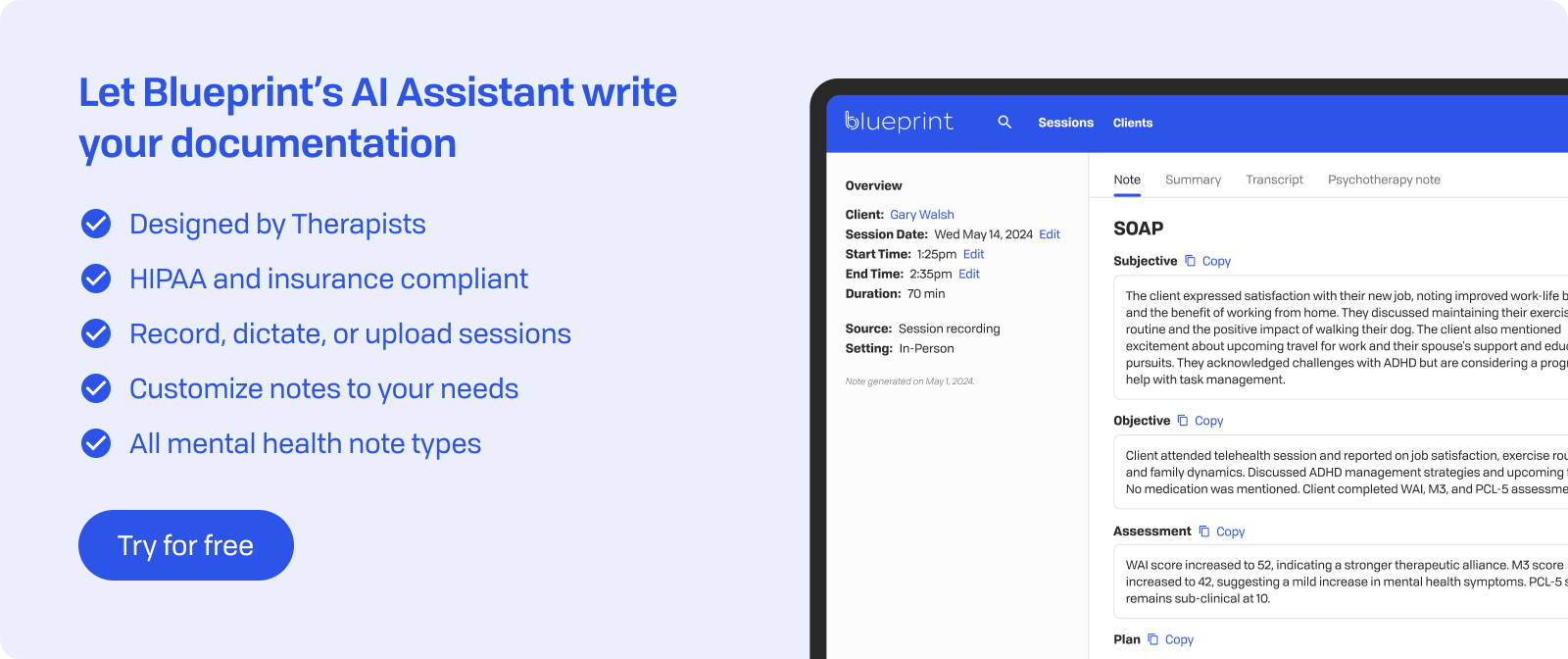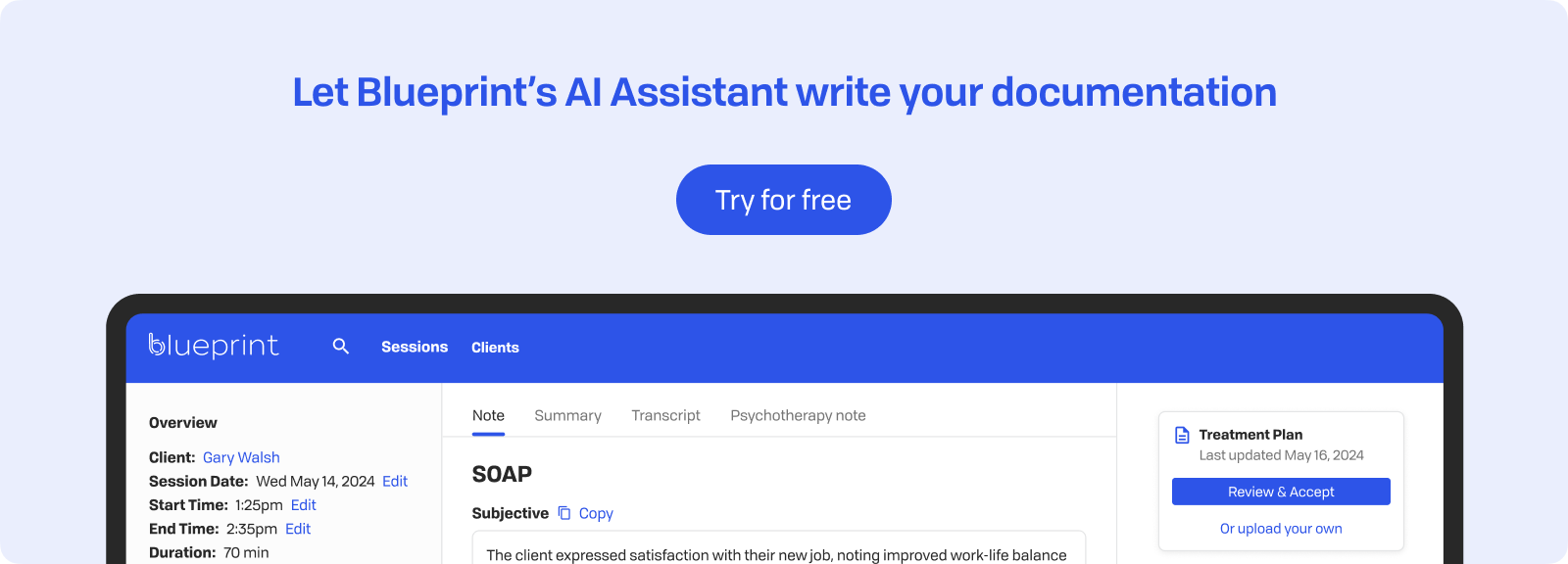In Brief
Let's address a situation familiar to almost every therapist. You finish your last session, head to your car, and suddenly replay a client's trauma story during dinner. Or maybe you're lying in bed, mentally preparing for seeing a certain client later in the week instead of sleeping.
The emotional weight of therapeutic work ignores office hours. When clients share their deepest struggles, those stories can follow us home, affecting our relationships, sleep, and overall well-being. This hidden burden presents one of the profession's biggest challenges.
Learning to leave work at work isn't just about improving work-life balance—it’s vital for sustainable practice. Without clear boundaries between professional and personal life, therapists risk burnout, compassion fatigue, and reduced clinical effectiveness. Fortunately, evidence-based strategies can help.
How Spillover Works
Work stress infiltrates personal life through multiple channels. During commutes, instead of unwinding, many therapists ruminate on tough sessions or worry about at-risk clients. This mental rehearsal keeps the nervous system activated long after leaving the office.
At home, the spillover continues in various ways. Some therapists feel frustrated that they can’t vent to partners about challenging cases because they can’t break confidentiality. Or they unintentionally snap at their kids because they have no gas left in their emotional tank. Others struggle to switch off "therapist mode," staying hypervigilant to others' emotions even with family and friends.
The physiological effects of this stress are significant. Chronic stress response activation can lead to elevated cortisol levels, disrupted sleep patterns, and increased inflammation.
Psychologically, the impact can be just as deep. Compassion fatigue—emotional exhaustion from prolonged exposure to client suffering—affects up to 40% of mental health professionals. Risk factors include high caseloads, trauma-focused work, and limited support at work. This emotional depletion doesn't just affect therapists' personal lives; it directly impacts their ability to stay present and effective with clients.
Handling multiple client narratives creates what is known as"emotional labor spillover." This happens when managing emotions professionally drains resources needed for personal emotional regulation. Therapists may find themselves emotionally unavailable to loved ones or struggling to enjoy activities they once did.

Establishing and Reinforcing Boundaries
Creating clear separations between work and personal life lays the groundwork for a sustainable practice. These boundaries are vital tools for conserving your emotional energy and preventing burnout.
Time boundaries require discipline but provide immediate benefits:
- Designated work hours: Set specific start and end times for client-related activities, including documentation and email responses. Clearly communicate these hours to clients and colleagues and set up systems, such as turning do not disturb on your phone, to hold them.
- Tech-free zones: Establish periods when work devices are off-limits. Many therapists find success with a "digital sunset" rule—no work emails or texts after a certain hour.
- Buffer time: Schedule 15-30 minute transitions between your last session and personal time. Use this space for decompressing rather than rushing into evening activities.
Space boundaries create psychological separation:
- Dedicated workspace: If working from home, designate a specific area for sessions. When you leave this space, you symbolically leave work behind.
- Visual cues: Close your office door, cover your computer, or perform a simple ritual that signals the end of the workday.
- Separate devices: Consider using different devices or user profiles for work and personal activities to avoid accidental exposure to work content during off-hours.
Therapists who maintain clear boundaries tend to have lower burnout rates and higher job satisfaction. These boundaries also set an example for clients, demonstrating that self-care is necessary for effective therapeutic work.
The key lies in consistency. Boundaries only work when enforced regularly, even when it feels uncomfortable or inconvenient.

Cultivating Mindful Routines and Transition Rituals
Transition rituals help you set clear boundaries between your therapeutic work and personal life. These practices signal to your nervous system that it's time to shift gears, allowing you to let go of any emotional residue from sessions.
Post-session resets can take place immediately after each client:
- Sensory grounding: Wash your hands with awareness, noting the water's temperature and texture. This simple act offers both symbolic cleansing and a sensory reset.
- Breathing breaks: Take three deep breaths, imagining releasing the session's energy with each exhale.
- Movement resets: Stand, stretch, or complete a quick body scan to release physical tension held during the session.
End-of-day transitions involve more substantial rituals:
- Intentional commutes: Use travel time to unwind rather than dwell on work. Listen to music, podcasts unrelated to therapy, or practice mindful observation of your surroundings.
- To do list for tomorrow: Jot down key tasks for the next day to offload mental clutter and signal to your brain that work is done for now and it can relax.
- Brief walks: A 10-minute walk after your last session creates physical and mental distance from work.
- Journaling practice: Write three sentences about the day—what went well, what was challenging, and what you're leaving at the office.
Daily mindfulness habits strengthen your ability to compartmentalize. Whether it's morning meditation, progressive muscle relaxation, or simple breathing exercises, these tools you suggest to clients work just as well for therapists. The key is consistency—even five minutes daily helps protect against work spillover.
Try linking your ritual to an existing behavior. Closing your laptop, turning off office lights, or locking your office door can become powerful signals that work has ended.
Practicing Self-Care and Physical Resilience
Self-care isn't a luxury for therapists—it's necessary for maintaining professional effectiveness. These grounding habits help protect against emotional exhaustion while improving your presence both during sessions and at home.
Sleep hygiene sets the stage for resilience:
- Consistent schedule: Stick to regular sleep and wake times, even on weekends.
- Wind-down routine: Allow a 30-minute period before bed without screens or work-related content.
- Environment optimization: Ensure your bedroom is cool, dark, and free from work materials.
Regular exercise offers both physical and emotional benefits:
- Movement variety: Include a mix of cardio, strength training, and gentle practices like yoga or tai chi.
- Timing matters: Morning exercise can energize you for the day, while evening activity helps relieve accumulated stress.
- Realistic goals: Even 20 minutes of daily movement can significantly reduce the risk of burnout.
Restorative leisure helps recharge emotional energy:
- Creative outlets: Participate in activities unrelated to therapy, such as painting, gardening, or cooking.
- Social connections: Maintain friendships outside the mental health field.
- Mindful relaxation: Engage in activities that require present-moment focus without analysis.
Self-compassion guards against self-criticism:
- Normalize struggles: Understand that difficulty in leaving work behind is common among therapists.
- Practice what you preach: Extend the same compassion you offer clients to yourself.
- Set realistic expectations: Complete work-life separation isn't the goal—progress is.
Research shows that these practices reduce emotional exhaustion and improve job satisfaction. When you focus on physical and emotional well-being, you demonstrate healthy boundaries for clients while maintaining your ability to be present therapeutically.

Professional Support and Peer Connection
Handling the emotional weight of therapeutic work requires more than just individual coping strategies—it calls for connection with others who understand the unique challenges of this profession. Regular consultation and supervision offer important outlets for discussing emotionally taxing sessions while preventing the buildup of secondary trauma.
Peer consultation offers many benefits:
- Shared understanding: Fellow therapists immediately grasp the complexities of difficult cases without needing extensive explanation.
- Normalized experiences: Hearing about colleagues' similar struggles reduces feelings of isolation and self-doubt.
- Fresh perspectives: Peers can spot patterns or suggest interventions you might overlook when emotionally invested.
- Mutual support: Regular consultation groups create accountability for maintaining boundaries.
Clinical supervision provides multiple protective functions for unlicensed and student therapists:
- Case processing: A structured space to explore countertransference and emotional reactions.
- Professional development: Guidance on managing challenging dynamics while preserving personal well-being.
- Early intervention: Supervisors can identify signs of compassion fatigue before it becomes overwhelming.
Personal therapy remains one of the most effective tools for therapists for growing as a clinican and enhancing well-being. Having your own therapeutic space allows you to process work-related stress without burdening personal relationships. It models the importance of seeking help and provides firsthand experience of being in the client role.
Organizations play a significant role in preventing burnout through supportive policies. Workplaces that prioritize regular supervision, encourage peer consultation time, and support therapists seeking their own therapy create environments where leaving work at work becomes more achievable. When leadership acknowledges the emotional demands of therapeutic work, it legitimizes the need for professional support systems.
Maintaining Healthy Workload and Organizational Self-Advocacy
Creating sustainable work practices involves thoughtful management of your caseload and actively advocating for systemic support. Without these elements, even good boundary-setting efforts can fall short.
Session pacing strategies help protect your emotional reserves:
- Time blocking: Schedule demanding clients earlier in the day when energy levels are highest, with lighter sessions toward the end
- Buffer periods: Include 15-minute transitions between emotionally intense sessions to process and reset
- Weekly balance: Spread trauma-focused or crisis work throughout the week instead of concentrating on specific days
- Client mix: Keep variety in presenting issues to avoid emotional monotony
Caseload management requires honest self-assessment:
- Know your limits: Track how many high-acuity clients you can effectively serve without compromising care quality
- Regular evaluation: Review your caseload monthly, noting patterns of exhaustion or decreased effectiveness
- Other income streams: Consider reducing overall client numbers while growing income through services, such as writing, providing supervision, or consulting, that do not include direct client care.
Organizational advocacy fosters lasting change:
- Propose solutions: Suggest concrete ideas for workload redesign, such as protected documentation time or caseload caps
- Build alliances: Connect with colleagues facing similar challenges to advocate collectively
- Negotiate boundaries: Clearly communicate your availability limits and adhere to them consistently
When organizations support realistic workloads through policy, therapists can maintain the emotional capacity necessary for effective practice. This approach isn't about doing less—it’s about structuring work in a way that enables sustained, high-quality care without sacrificing personal well-being.

Key Takeaways
Figuring out how to leave work at work involves making deliberate choices rather than hoping boundaries will form on their own. The most successful methods include several layers of protection against emotional spillover:
- Boundary setting: Define clear time and space boundaries, such as specific work hours, tech-free zones, and dedicated workspaces that help separate professional and personal life.
- Mindful transition rituals: Use post-session resets and end-of-day practices that signal your nervous system to switch from therapist mode to personal time, whether through sensory grounding, brief walks, or journaling.
- Self-care integration: Make sleep hygiene, regular exercise, and restorative activities a priority—these aren't extras but important tools for maintaining effectiveness in therapy.
- Professional support systems: Participate in regular peer consultation, clinical supervision, and personal therapy to manage the emotional weight of client work without it affecting personal relationships.
- Systemic advocacy: Actively manage your workload, negotiate realistic expectations, and push for organizational policies that support therapist well-being and sustainable practice.
Leaving work at work is an act of self-care. Modeling healthy boundaries and self-care shows clients that emotional well-being requires effort. This practice not only supports your mental health but also improves the quality of care you provide. The aim is not perfection, but creating sustainable habits that allow you to be fully present both in sessions and in your personal life.

How Blueprint can help streamline your workflow
Blueprint is a HIPAA-compliant AI Assistant built with therapists, for the way therapists work. Trusted by over 50,000 clinicians, Blueprint automates progress notes, drafts smart treatment plans, and surfaces actionable insights before, during, and after every client session. That means saving about 5-10 hours each week — so you have more time to focus on what matters most to you.
Try your first five sessions of Blueprint for free. No credit card required, with a 60-day money-back guarantee.
























